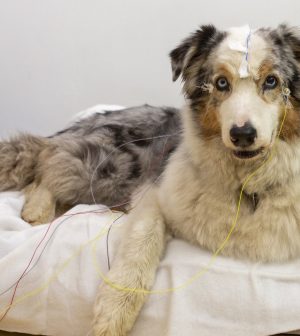- Navigating Your Midlife Crisis: Embracing New Possibilities
- City Raccoons Showing Signs of Domestication
- Mapping the Exposome: Science Broadens Focus to Environmental Disease Triggers
- One Week Less on Social Media Linked to Better Mental Health
- Your Brain Changes in Stages as You Age, Study Finds
- Some Suicide Victims Show No Typical Warning Signs, Study Finds
- ByHeart Formula Faces Lawsuits After Babies Sickened With Botulism
- Switch to Vegan Diet Could Cut Your Greenhouse Gas Emissions in Half
- Regular Bedtime Does Wonders for Blood Pressure
- Dining Alone Could Mean Worse Nutrition for Seniors
Your Dog May Understand Words for Certain Objects

It’s well-known that dogs can learn words for spoken commands like “sit,” “stand” and “heel.”
But a new study has found they also can tell their “ball-ball” from their “dolly,” “teddy,” “chewy” or “squeaky squeak.”
Brain scans reveal that dogs generally know that certain words stand for certain objects, researchers reported March 22 in the journal Current Biology.
Words “activate a memory of an object when they hear its name,” researcher Marianna Boros of Eötvös Loránd University in Budapest, Hungary, said in a news release.
For the study, researchers hooked 18 dogs up to an EEG, to see how deep each canine’s understanding of language runs.
The dogs’ owners would say words for toys that their dogs knew and then present objects to them – sometimes the matching toy, sometimes another object.
For example, an owner would say, “Zara, look, the ball,” and then show them a ball.
Brain recording results showed that patterns differed when dogs were offered a matching object versus a mismatched one, in ways similar to what is seen in humans. This is solid evidence that they understand the words, researchers said.
This difference doesn’t depend on a dog having a large vocabulary, counter to what the research team expected.
“Because typical dogs learn instruction words rather than object names, and there are only a handful of dogs with a large vocabulary of object words, we expected that dogs’ capacity for referential understanding of object words will be linked to the number of object words they know,” researcher Lilla Magyari with Eötvös Loránd University and the University of Stavanger in Norway said in a news release.
They instead found that it doesn’t matter how many object words a dog understands, Boros said.
“Known words activate mental representations anyway, suggesting that this ability is generally present in dogs and not just in some exceptional individuals who know the names of many objects,” Boros said.
These findings could reshape the way researchers think about how humans understand and use language, and how they evolved to begin using language, Magyari said.
It’s also an important realization for dog owners.
“Your dog understands more than he or she shows signs of,” Magyari said. “Dogs are not merely learning a specific behavior to certain words, but they might actually understand the meaning of some individual words as humans do.”
The next steps in this research will be to see if other animals can learn object names in the same way as dogs, or if dogs’ unique experience of living with people helped them develop this ability, researchers said.
More information
The American Kennel Club has more on canine language skills.
SOURCE: Eötvös Loránd University, news release, March 22, 2024
Source: HealthDay
Copyright © 2025 HealthDay. All rights reserved.










